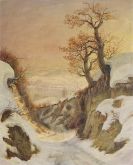
Giorgio de Chirico
Volos
1888 -
Rom
1978
The Italian painter and graphic artist Giorgio de Chirico was born in Volvos, Greece, on July 7, 1888. He attends the drawing class of the Polytechnic School in Athens, later he and his brother - who became a famous composer, painter and writer under the pseudonym Alberto Savinio - go to Munich, where he studies at the Academy of Fine Arts from 1906 to 1909. He encounters paintings by Arnold Böcklin, Max Klinger and Alfred Kubin in Munich for the first time, which leave a great impression on him. Giorgio de Chirico also deals with music and the philosophical writings of Arthur Schopenhauer and especially of Friedrich Nietzsche.
Giorgio de Chirico goes to Italy in 1909, living in Milan, he visits Turin, Florence and other cities. He is in Paris from 1911 to 1915, participating in exhibitions in the Salon d'Automne and the Salon des Indépendants. The choice of topics and the atmosphere of his paintings show the strong influence of Friedrich Nietzsche's works. Reality and dream worlds mingle, he paints fantastic ideal architecture and city and landscapes views, strictly following the rules of perspectives, in them he places single statues and the "Manichini" - faceless manikins, that seem to be lost in the surroundings. The artist focusses more and more on the artistic quality of his paintings. He makes the first paintings of the "Piazze d'Italia" as of 1912. Guillaume Apollinaire writes a critique on occasion of a salon exhibition of Giorgio de Chirico's "Metaphysic Landscapes".
In a military hospital in Ferrara he meets the painter Carlo Carrà in 1917, who decides to join him. They express the basic theories of the "Pittura Metafisica" after the war, which Chirico will publish in form of articles for the magazine "Valori Plastici".
The artist goes to Paris again in 1925. He is a friend of the surrealist painters Max Ernst, René Magritte, Yves Tanguy and Salvador Dalí. The surrealists acknowledge his painting just as much as the painters of New Objectivity and Magic Realism.
Giorgio de Chirico also makes stage and costume designs, for instance for Sergej Diaghilew's "Ballets Russes". In 1929 he writes the autobiographic novel "Hebdomeros, Le peintre et son génie chez l'ecrivain". He executes numerous series of lithographs in the 1930s, he illustrates, for instance, the "Calligrammes" by Apollinaire in 1930, and Jean Cocteau's "Mythology" in 1934. As of 1937 he works on the series "Bagni Misteriosi". He stays in the USA from 1935 to 1937, then returns to Italy and finally settles in Rome in 1945.
Giorgio de Chirico's compositions become more conventional as of the late 1930s. He draws some of his earlier metaphysic works again, some of them he even dates back.
Giorgio de Chirico dies in Rome on November 11, 1978.
Would you like to sell a work by Giorgio de Chirico?
Infos for seller












